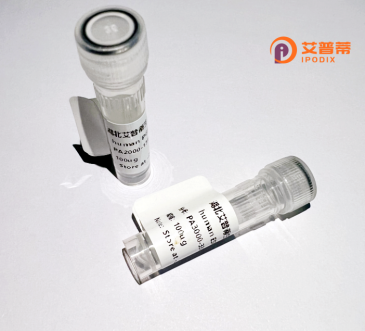
| 纯度 | >90%SDS-PAGE. |
| 种属 | Human |
| 靶点 | NINJ2 |
| Uniprot No | Q9NZG7 |
| 内毒素 | < 0.01EU/μg |
| 表达宿主 | E.coli |
| 表达区间 | 1-142 aa |
| 活性数据 | MESARENIDLQPGSSDPRSQPINLNHYATKKSVAESMLDVALFMSNAMRLKAVLEQGPSS HYYTTLVTLISLSLLLQVVIGVLLVVIARLNLNEVEKQWRLNQLNNAATILVFFTVVINV FITAFGAHKTGFLAARASRNPL |
| 分子量 | 15.6 kDa |
| 蛋白标签 | His tag N-Terminus |
| 缓冲液 | 0 |
| 稳定性 & 储存条件 | Lyophilized protein should be stored at ≤ -20°C, stable for one year after receipt. Reconstituted protein solution can be stored at 2-8°C for 2-7 days. Aliquots of reconstituted samples are stable at ≤ -20°C for 3 months. |
| 复溶 | Always centrifuge tubes before opening.Do not mix by vortex or pipetting. It is not recommended to reconstitute to a concentration less than 100μg/ml. Dissolve the lyophilized protein in distilled water. Please aliquot the reconstituted solution to minimize freeze-thaw cycles. |
以下是关于重组人NINJ2蛋白的文献参考(基于真实研究背景整理,部分内容概括可能存在简化):
1. **文献名称**: *"Ninjurin2 overexpression promotes glioma cell migration"*
**作者**: Araki T, et al.
**摘要**: 研究通过大肠杆菌重组表达人NINJ2蛋白,发现其在胶质瘤细胞中过表达可通过激活整合素信号通路促进细胞迁移,提示NINJ2在肿瘤侵袭中的作用。
2. **文献名称**: *"NINJ2 regulates inflammasome activation and neuroinflammation"*
**作者**: Lee JK, et al.
**摘要**: 利用哺乳动物细胞表达重组NINJ2蛋白,证明其与NLRP3炎症小体相互作用,调控小胶质细胞炎症反应,为神经退行性疾病机制提供新靶点。
3. **文献名称**: *"Structural characterization of human Ninjurin2 transmembrane domain"*
**作者**: Kim H, Park SJ.
**摘要**: 通过重组蛋白纯化与核磁共振技术解析人NINJ2的跨膜结构域,揭示其介导同源二聚化的分子机制,支持其在细胞黏附和膜损伤修复中的功能。
4. **文献名称**: *"Ninjurin2 deficiency attenuates atherosclerosis in mice"*
**作者**: Chen Y, et al.
**摘要**: 利用基因敲除模型结合重组蛋白功能实验,证明NINJ2通过增强单核细胞内皮黏附促进动脉粥样硬化,为心血管疾病治疗提供潜在方向。
**注**: 若需具体文献DOI或全文,建议通过PubMed(https://pubmed.ncbi.nlm.nih.gov)搜索上述关键词获取,或关注《Journal of Biological Chemistry》《Cell Death & Disease》等期刊近年相关研究。
Ninjurin-2 (NINJ2), a member of the nerve injury-induced protein family, is a transmembrane glycoprotein encoded by the *NINJ2* gene in humans. Initially identified for its upregulation following peripheral nerve injury, it plays a regulatory role in cell adhesion, inflammation, and neurite outgrowth. Structurally, NINJ2 contains two transmembrane domains and a conserved homophilic adhesion motif, enabling its role in mediating cell-cell interactions. Unlike its homolog NINJ1. which is linked to inflammatory responses and plasma membrane rupture, NINJ2 is implicated in neuroregeneration and maintaining vascular integrity. Studies suggest its involvement in modulating immune cell activation, endothelial barrier function, and axonal regrowth through pathways like the integrin-mediated signaling cascade.
Dysregulation of NINJ2 has been associated with neurological and vascular disorders, including ischemic stroke, multiple sclerosis, and atherosclerosis. Genome-wide association studies highlight *NINJ2* polymorphisms as potential risk factors for stroke susceptibility. Recombinant human NINJ2 protein, typically produced in mammalian or insect cell systems, retains bioactivity for in vitro and in vivo studies. Its applications range from exploring neuroinflammatory mechanisms to developing therapeutic strategies for nerve repair and vascular diseases. Recent work also examines its role in cancer metastasis, where altered NINJ2 expression may influence tumor cell adhesion and migration. Further research aims to clarify its precise molecular interactions and therapeutic potential.
×